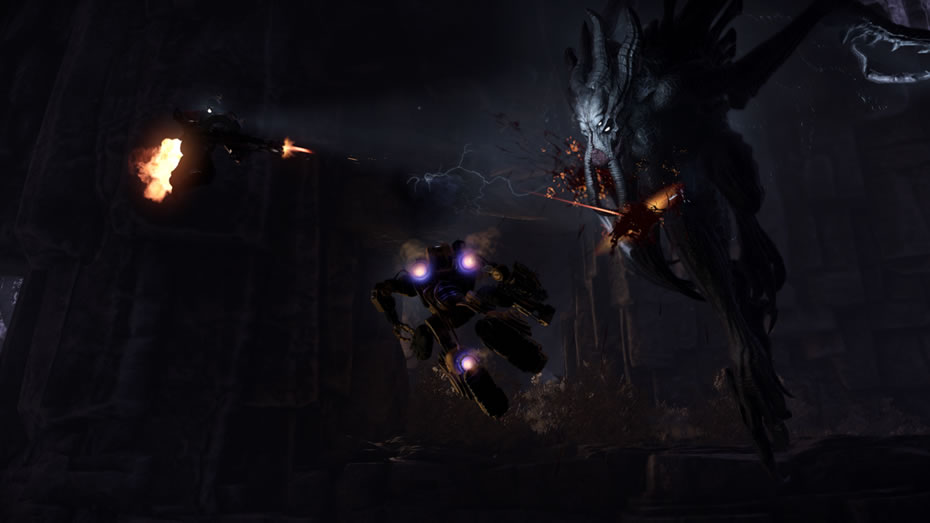
Halfway through my hands-on time with Evolve, I could feel the disappointment of the 2K representative next to me. I was still getting the hang of the game, and my gigantic, flying Kraken had taken lots of damage from the four players trying to bring it down. Reading the rep’s face, a comeback seemed like a long shot.
But then, something clicked. I started using the Kraken’s powers more effectively, pinpointing my lightning blasts at exposed monster hunters, while keeping them on the defensive with a barrage of energy blasts from high in the air. I got better at dividing and conquering the hunters, and when one went down, he became bait as the other players tried to revive their fallen comrade. When the last monster hunter fell, I had only a sliver of health left, and my hands were shaking.
Evolve is strictly a multiplayer game, coming to PlayStation 4, Xbox One and PC this fall. Four players team up and control the hunters, each with their own special abilities, while a fifth player controls an oversized monster with a handful of super powers. Over the course of a match, the monster can feed on creatures and “evolve” into a more powerful form, so there’s an element of hide-and-seek as the monster tries to become better equipped for fighting the hunters.
It was hard to believe my outcome wasn’t scripted, or at least pushed toward a thrilling conclusion through unseen handicaps. But speaking to Chris Ashton, the game’s design director, he assured me that Evolve’s mechanics are pure, with no extra assistance for ailing players.
“In a racing game, sometimes they’ll make the guy in the back go faster,” Ashton said. “But when you’re a seriously competitive game, you don’t want to artificially give the losing team an advantage or Nerf the winning team at all.”
There are, however, some subtle forces at work. The trapper, for instance, needs lots of time to recharge its containment field, so every few minutes, the monster has a chance to get away and get back to feeding. Meanwhile, the Kraken’s flying ability takes longer to recharge when it’s not in combat, so it’s much easier for the hunters to eventually catch up. Ashton said this creates a roller coaster effect, similar to the Turtle Rock’s use of safe rooms in its previous series, Left 4 Dead.
“We ratchet everything up, and then we ratchet everything back down so you have time to recover,” he said.
Evolve’s sense of balance comes from more than three years of prototyping and testing. The game was bare bones at first, with just a melee attack for the monster and assault rifles for the hunters. As the developers layered on new abilities–such as healing powers for the medic, a containment field for the trapper class, and a slew of special powers for the monsters–they constantly had to rebalance.
The entire studio would play the game for an hour every day, and their matches fed into a telemetry system to help the developers figure out which characters were too weak, or too strong. So by the time 2K started showing Evolve at public and industry events, Ashton expected plenty of close matches.
“We’ve played the game so much that there aren’t really any surprises,” he said.
Still, he thinks this will change when Evolve launches on October 21, and players start learning all the game’s tricks. One of the advantages of the latest game consoles is that it’s much easier to push out updates, so Turtle Rock plans to keep tuning the mechanics long after the game comes out.
“We know that once we release, if we sell millions of copies in the first day, there’s going to be millions of man-hours played,” Ashton said, “And that’s more than we’ve put into the game.”
More Must-Reads from TIME
- Donald Trump Is TIME's 2024 Person of the Year
- Why We Chose Trump as Person of the Year
- Is Intermittent Fasting Good or Bad for You?
- The 100 Must-Read Books of 2024
- The 20 Best Christmas TV Episodes
- Column: If Optimism Feels Ridiculous Now, Try Hope
- The Future of Climate Action Is Trade Policy
- Merle Bombardieri Is Helping People Make the Baby Decision
Contact us at letters@time.com